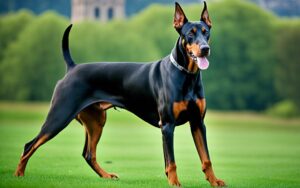
Historical Significance of Dogs, Dogs have played a vital role throughout human history, holding deep cultural and historical significance. These loyal and faithful creatures have been cherished companions, esteemed protectors, and revered symbols in different cultures and civilizations.
From ancient civilizations to modern societies, dogs have left an indelible mark on our collective consciousness. They have been valued members of households, working alongside humans as hunters, herders, and guards. Dogs have been revered as spiritual beings, believed to possess mystical qualities and serve as guides in the afterlife.
Dogs’ impact on society extends beyond their practical contributions. They have become entrenched in cultural beliefs and folklore, symbolizing qualities such as loyalty, bravery, and devotion. Their presence in art, literature, and religious rituals further reflects their enduring influence on human civilization.
Join us as we delve into the historical and cultural significance of dogs, exploring their role in different cultures, the symbolism attached to them, and their impact on human society throughout history.
Key Takeaways: Historical Significance of Dogs
- Dogs have been integral to human society, serving as companions, protectors, and hunting partners throughout history.
- They have held cultural and historical significance in various civilizations, symbolizing qualities like loyalty and bravery.
- Art, literature, and religious rituals have featured dogs, showcasing their enduring impact on human civilization.
- Dogs’ roles have evolved with changing societies, but their bond with humans remains strong.
- Owning a dog has been proven to have positive health impacts, such as lower blood pressure and reduced stress.
The Origins of Dogs: The Domestication Process
Dogs are believed to have descended from ancient wild wolves, but the exact process of domestication is still a topic of debate among experts. Research suggests that humans interacted with wild wolves between 15,000 and 40,000 years ago, leading to the gradual domestication of these animals. DNA studies have shown that dogs were domesticated twice, in eastern Eurasia and western Eurasia, and then brought together through human migration.
The domestication of dogs is a fascinating subject that sheds light on the close relationship between humans and canines. Ancient humans likely encountered wild wolves and formed mutually beneficial bonds with them. Over time, these wild wolves adapted to human presence and became the familiar companions we know today as dogs.
“The origin of the domestic dog has been a subject of interest and speculation for centuries, and DNA research has provided valuable insights into this process. By studying the genetic makeup of ancient dogs and comparing it to that of modern breeds, scientists have been able to uncover important clues about their ancestry and domestication history.” – Dr. Jane Anderson, Canine Geneticist
Theories of Dog Domestication
There are several theories surrounding the domestication of dogs. One prevailing theory suggests that early humans began to form relationships with wild wolf pups, raising them as companions. This gradual process of taming and selection for desirable traits eventually led to the emergence of distinct dog breeds.
Another theory proposes that dogs and humans formed mutually beneficial partnerships through cooperation in hunting and scavenging. Wolves, with their keen sense of smell and hunting abilities, would have been valuable partners to early humans. Over time, these collaborative efforts may have facilitated the domestication of wolves into dogs.
DNA Studies of Ancient Dogs
To gain further insights into the domestication process, scientists have conducted DNA studies on ancient dog remains. These studies have revealed genetic similarities between ancient dogs and modern canines, providing evidence of their common ancestry.
One such study examined the genomes of ancient dogs from different regions. It revealed that dogs were domesticated independently in two separate events, resulting in distinct genetic lineages. The first domestication event occurred in eastern Eurasia, likely in present-day China or Southeast Asia. The second event took place in western Eurasia, possibly in Europe or the Near East. These two lineages eventually converged as humans migrated and populations mixed.
These DNA studies not only shed light on the domestication process but also help trace the migration patterns of ancient humans and the dogs they lived alongside.
Continuing the Journey
The origins of our beloved canine companions are still being explored and understood. DNA studies of ancient dogs and ongoing research into their domestication process continue to provide valuable insights.
Next, we’ll delve into the fascinating role of dogs in ancient civilizations, exploring their cultural significance and the diverse bonds they formed with human societies.
Dogs in Ancient Civilizations
Dogs have held a significant place in the hearts and minds of people in ancient civilizations. Through archaeological discoveries, we have gained valuable insights into their deep connection with humans. One notable aspect is the burial practices, where dogs were often laid to rest alongside humans, indicating a profound bond between the two species. This practice suggests that dogs were not merely companions and protectors, but cherished members of ancient societies.
In addition to their physical presence, dogs also held spiritual significance in many cultures. They were considered spiritual symbols and believed to guide souls to the afterlife. In cultures such as ancient Egypt, dogs were associated with Anubis, the god of embalming and the afterlife. These beliefs further reinforce the close relationship between dogs and spirituality in ancient times.
Ancient artwork provides further evidence of the reverence and admiration for dogs. Depictions of dogs can be found in art from a variety of ancient civilizations, including Greek, Roman, Chinese, Indian, and Egyptian. These representations showcase the cultural significance of dogs in various forms, from hunting scenes to mythological narratives. Dogs were seen as symbols of loyalty, fidelity, and protection, capturing the essence of their relationship with humans.
Dogs in Ancient Artwork
| Ancient Civilization | Artwork Description |
|---|---|
| Greek | Depictions of hunting scenes with dogs as loyal companions. |
| Roman | Mosaics and statues portraying dogs as protectors and symbols of loyalty. |
| Chinese | Dogs featured in artwork representing prosperity, fidelity, and protection. |
| Indian | Depictions of gods and goddesses accompanied by dogs as divine companions. |
| Egyptian | Dogs depicted as guardians and companions of the deceased in funerary art. |
These ancient artworks not only provide insights into the role of dogs in their respective cultures but also reflect the enduring fascination and admiration for these loyal creatures throughout the ages.
Dogs with Specialized Roles in Human Society
Dogs have been trained for a wide range of specialized roles throughout history and continue to play vital roles in modern society. Their exceptional skills and abilities make them indispensable in various fields, serving alongside humans in different capacities.
Working Dogs
“Working dogs are highly trained canines that perform specific tasks to assist humans in various industries.”
- Police Dogs: Police dogs, also known as K-9 units, are trained to assist law enforcement agencies in maintaining public safety. They excel in tracking suspects, locating evidence, and apprehending criminals.
- Military Dogs: Military dogs play a crucial role in armed forces around the world. They are trained for activities such as bomb detection, search and rescue missions, and providing support during combat operations.
- Search and Rescue Dogs: These specially trained dogs assist in locating missing persons during emergencies, natural disasters, or wilderness situations. Their exceptional sense of smell and agility enable them to cover large areas quickly and efficiently.
- Guide Dogs: Guide dogs, also known as seeing-eye dogs, are trained to assist individuals with visual impairments. With their remarkable ability to navigate obstacles, these dogs provide independence and enhance mobility for their visually impaired handlers.
- Emotional Support Animals: Emotional support animals provide comfort and companionship to individuals with emotional or psychological conditions. They offer emotional support, reducing anxiety and stress, and are commonly used in therapeutic settings.
- Disease Detection Dogs: These remarkable canines are trained to detect various diseases and medical conditions, including cancer, diabetes, and seizures. They can identify changes in odor or behavior associated with certain illnesses, aiding in early detection and diagnosis.
The Importance of Working Dogs
Working dogs are an integral part of society, contributing to public safety, health, and well-being. Their specialized skills, advanced senses, and unwavering loyalty make them invaluable assets in their respective fields. These exceptional canines continue to prove their worth and demonstrate the profound impact dogs can have on human society.
| Working Dogs | Roles and Responsibilities |
|---|---|
| Police Dogs | Aid in law enforcement activities, including tracking suspects and apprehending criminals. |
| Military Dogs | Assist in bomb detection, search and rescue missions, and combat support. |
| Search and Rescue Dogs | Locate missing persons during emergencies and natural disasters. |
| Guide Dogs | Assist individuals with visual impairments, providing guidance and enhancing mobility. |
| Emotional Support Animals | Provide comfort and companionship to individuals with emotional or psychological conditions. |
| Disease Detection Dogs | Detect diseases and medical conditions through their extraordinary sense of smell. |
Dogs in Art and Literature
Dogs have long been depicted in art and literature, symbolizing various qualities such as loyalty, protection, and love. Throughout history, these faithful companions have captured the imagination of artists and writers, inspiring countless cultural depictions of dogs in paintings, sculptures, poems, and novels.
In the Middle Ages and Renaissance, dogs were often portrayed in hunting scenes, representing both the status of the nobility and their aristocratic lifestyle. These paintings showcased dogs as symbols of wealth, power, and the pursuit of leisure. Artists such as Titian, Velázquez, and Rubens masterfully captured the elegance, agility, and energy of these hunting dogs in their works.
“The greatest fear dogs know is the fear that you will not come back when you go out the door without them.”
– Stanley Coren
From ancient myths to classic literature, dogs have played significant roles in storytelling. In Homer’s epic poem, “The Odyssey,” the loyal dog Argos patiently waits for his master, Odysseus, to return home after his long journey. This tale exemplifies the unwavering loyalty and devotion that dogs have come to symbolize.
Children’s literature has also featured dogs prominently, providing young readers with moral lessons and tales of friendship. Characters like Lassie, Clifford the Big Red Dog, and the Hundred Acre Wood’s beloved companion, Goofy, have captured the hearts of generations, teaching valuable life lessons about kindness, courage, and the importance of unconditional love.
In visual arts, the enduring fascination with dogs as subjects continues to this day. Contemporary artists explore the emotional connection between humans and dogs, creating poignant and thought-provoking artworks. With their ability to convey deep emotions through their expressive eyes and body language, dogs remain beloved muses for many artists.
Dogs as Symbols and Status Symbols
Dogs have also served as symbols throughout history, representing various cultural and societal concepts. In some cultures, dogs symbolize loyalty, faithfulness, and protection. In others, they represent guardianship or spirituality. The ancient Egyptians, for example, revered Anubis, a canine-headed deity associated with mummification and the afterlife.
| Table | Depictions of Dogs as Status Symbols in Art |
|---|---|
| 1 | Paintings from the Middle Ages and Renaissance |
| 2 | Chinese guardian lion sculptures |
| 3 | Portraits of aristocracy with their prized hunting dogs |
| 4 | Japanese ukiyo-e prints featuring loyal dogs |
Throughout history, dogs have also been used as status symbols, representing wealth, power, and social standing. Portraits of aristocracy often featured individuals posing with their prized hunting dogs, showcasing their elevated position in society. Dogs, such as Chinese guardian lion sculptures or the Japanese ukiyo-e prints featuring loyal and protective dogs, were believed to bring good fortune and acted as symbols of prosperity.
Whether as subjects in paintings, characters in literature, or as symbols of cultural significance, dogs continue to captivate both artists and audiences alike. Their enduring presence in art and literature speaks to the profound impact these loyal companions have had on human culture and our collective imagination.
Dogs in Modern Culture
In modern culture, Historical Significance of Dogs have taken on new roles as beloved pets, reflecting the changing dynamics of our society. As more people recognize the emotional and physical benefits of having a canine companion, dogs have become an integral part of family life.
Unlike in the past, where dogs were primarily kept for practical purposes such as herding livestock or guarding property, dogs are now valued for their companionship and unconditional love. They are no longer merely working animals, but cherished members of the family.
This shift in perception is evident in the way we treat and care for our dogs. They have their own beds, toys, and even clothing, all highlighting their status as treasured pets. Dog grooming salons and spas are on the rise, offering a range of services to keep our furry friends looking and feeling their best.
One significant aspect of modern dog culture is the emphasis on dog breeding. Through selective breeding, specific breeds have been developed to suit various lifestyles and purposes. From small lapdogs to active sporting breeds, there is a wide variety of modern dog breeds available.
“The art of breeding dogs allows us to create breeds that possess desired traits and characteristics, whether it be intelligence, loyalty, or athleticism,” says Dr. Sarah Thompson, a renowned canine geneticist.
Modern dog breeds are carefully designed to meet the specific needs and preferences of dog owners. For example, if someone is looking for an energetic companion to join them on hikes or runs, they might consider a high-energy breed such as a Border Collie or a Labrador Retriever. On the other hand, individuals seeking a lapdog for apartment living might opt for a small breed like a Chihuahua or a Cavalier King Charles Spaniel.
This emphasis on breed selection has also led to an increased awareness of responsible dog ownership. Potential owners are encouraged to research breeds thoroughly, ensuring that they match their lifestyle, living conditions, and commitment level.
Furthermore, the changing roles of dogs in modern culture extend beyond companionship and breeding. Dogs are now involved in a wide range of activities and occupations. They work alongside police forces as K-9 officers, perform search and rescue missions, provide support and therapy for individuals facing emotional or physical challenges, and even participate in dog sports and competitions.
In summary, dogs have found a significant place in modern culture as cherished pets. The changing roles of dogs reflect societal shifts towards valuing emotional connection and companionship. Through selective breeding and responsible ownership practices, we have developed a diverse range of modern dog breeds suited to various lifestyles and preferences.
| Modern Dog Breeds | Characteristics |
|---|---|
| Labrador Retriever | Friendly, intelligent, and versatile. |
| German Shepherd | Loyal, protective, and highly trainable. |
| Poodle | Smart, hypoallergenic, and comes in different sizes. |
| Golden Retriever | Gentle, tolerant, and great with families. |
| Bulldog | Sociable, affectionate, and known for its distinctive appearance. |
The Bond Between Humans and Dogs
The bond between humans and dogs is a special and enduring one that stretches back through the annals of history. Not only do dogs provide companionship and loyalty, but scientific research has also revealed the fascinating physiological effects of this human-dog bond.
When humans and dogs interact, a hormone called oxytocin, often referred to as the “love hormone,” is released in both species. This chemical reaction creates feelings of love, trust, and companionship, forming a deep connection between humans and their canine companions.
The release of oxytocin during human-dog interactions has numerous health benefits. Studies have shown that owning a dog can lead to lower blood pressure, reduced levels of stress and depression, and increased physical activity. The presence of a dog has also been linked to a longer lifespan and improved overall well-being.
Furthermore, the human-dog bond extends beyond just physical and emotional health. Dogs have been utilized in various therapy settings, including assisting individuals with physical disabilities and providing emotional support to those with mental health conditions. These specially trained therapy dogs offer comfort, companionship, and a helping hand to those in need.
To underscore the significance of the human-dog bond, let’s take a look at a remarkable study conducted by the Department of Medical Physiology at the Rijksuniversiteit Groningen in the Netherlands. The researchers found that simply gazing into their dog’s eyes caused an increase in oxytocin levels in both humans and dogs, further solidifying the bond between them.
This intrinsic connection with dogs has been deeply embedded in our society, shaping our relationships with these remarkable animals. From the ancient Egyptians who revered dogs as guardians in the afterlife to the modern-day therapy dogs spreading joy and comfort, the human-dog bond continues to be a testament to the power of companionship and love.

It is clear that the bond between humans and dogs is not only scientifically supported but also deeply rewarding. From the release of oxytocin to the numerous health benefits of pet ownership, dogs have a remarkable impact on our lives and well-being. Through thick and thin, dogs have been loyal friends, confidants, and sources of joy since time immemorial.
Dogs in Different Occupations
Dogs play crucial roles in various occupations, utilizing their unique abilities and instincts. They serve as police dogs, assisting in law enforcement activities such as tracking and apprehending criminals.
In the military, dogs are trained for tasks such as bomb detection and patrol work. These highly skilled canines play a vital role in ensuring the safety and security of military personnel and facilities.
Therapy dogs provide comfort and emotional support to individuals in hospitals, nursing homes, and schools. Their calm and gentle nature helps alleviate stress and anxiety, making them valuable companions for those in need of emotional support.
Service dogs are specially trained to assist individuals with disabilities in their daily lives. From guiding visually impaired individuals to alerting those with hearing impairments, these dogs enhance the independence and quality of life for their human companions.
Whether it’s protecting communities, serving in the armed forces, providing comfort, or empowering individuals with disabilities, dogs in different occupations demonstrate the incredible bond between humans and canines. Their dedication and unwavering loyalty make them invaluable assets in a wide range of professional settings.
Police Dogs:
Police dogs, also known as K9 units, undergo rigorous training to assist law enforcement agencies in tasks such as tracking down suspects, detecting illegal substances, and conducting search operations. These highly trained dogs possess exceptional scent detection capabilities and physical agility, allowing them to help apprehend criminals and locate missing persons.
Military Dogs:
Military dogs serve alongside soldiers, providing support and protection in combat zones. They are extensively trained to detect explosives and locate hidden weapons, ensuring the safety of military personnel. Additionally, military dogs may be trained for search and rescue operations, helping locate survivors in disaster-stricken areas.
Therapy Dogs:
Therapy dogs are known for their ability to provide comfort and emotional support to individuals in various settings. From hospitals and nursing homes to schools and rehabilitation centers, these dogs bring joy and a calming presence to those they interact with. Their gentle nature and unconditional love have a profound impact on the well-being of individuals going through challenging times.
Service Dogs:
Service dogs are trained to assist individuals with disabilities, allowing them to navigate their daily lives with greater independence. These dogs can be trained for a range of tasks, including guiding individuals with visual impairments, alerting individuals with hearing impairments to sounds, and providing stability and mobility support for individuals with physical disabilities. Service dogs are essential companions, enabling individuals to live fulfilling and empowered lives.
Conclusion: Historical Significance of Dogs
Dogs have been humans’ cherished companions throughout history, forging an enduring bond that transcends time and cultures. They have played diverse roles, from loyal friends to trusted protectors, leaving an indelible impact on human society.
From ancient civilizations to modern times, dogs have been revered for their unwavering loyalty and unconditional love. They have stood by our side, offering comfort and companionship in times of joy and solace in times of sorrow. Their presence has enriched our lives in countless ways.
The enduring bond between humans and dogs goes beyond mere companionship. Research has shown that when humans interact with dogs, a release of oxytocin occurs in both species, fostering feelings of love, trust, and emotional connection. This unique relationship has not only brought immeasurable joy and happiness, but it has also provided significant health benefits, including lower blood pressure, reduced stress and depression, increased physical activity, and enhanced overall well-being.
In addition to their role as beloved pets, dogs have made invaluable contributions to society. They have served as assistance animals to individuals with disabilities, working alongside law enforcement and military personnel, and providing therapeutic support to those in need. Their dedication, intelligence, and unwavering loyalty have made them indispensable partners in various occupations.





















